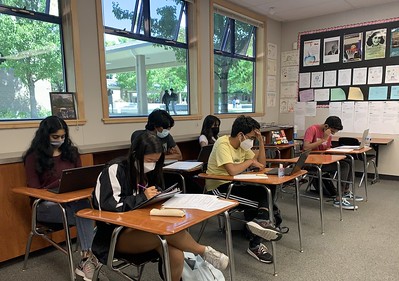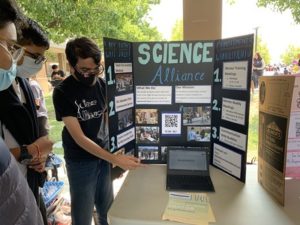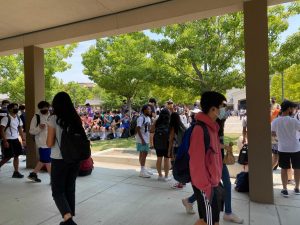Chromebooks: the effect of increased technology usage in classrooms

Following the distribution of Chromebooks to all students, technology has started playing a bigger role in class activities.
October 15, 2021
In fall 2021, SRVUSD’s “One to One Device Initiative” distributed Chromebooks to all students in the district in order to engage students in the creativity, critical thinking, communication and collaboration that is vital to classroom instruction.
“Technology has been integrated into learning,” DVHS Assistant Principal Charlie Litten said. “I think there’s a benefit to writing [on paper] … but to say every kid has access to … similar technology levels the playing field.”
As thousands of schools across California transitioned to virtual learning in April 2020, the California Department of Education created the Closing the Digital Divide Task Force to provide more equitable learning environments for all students. In the year of virtual learning that followed, many classes have become more dependent on technology for classroom activities and instruction.
“Last year, we created everything digitally,” anatomy teacher Pia Murphy said. “We worked a long time to develop all these cool labs and we found these online microscopes. And, I don’t know, we just did a lot of fun things. So when we came back this year, after all the work we put in, we really wanted to continue using that.”
On the other hand, some teachers such as government teacher Rick LaTorra were already regularly using technology in classes prior to the pandemic in order to give students more independence in their own learning.
“Tech allows the ability to have people flow and to work on what is important for them to work on in the moment,” LaTorra said. “You don’t necessarily have to have that teacher mediate when they start when they stop. It allows them to go deeper, or to very quickly demonstrate their knowledge without having to go through the same rote procedures to get there.”
In addition to being able to choose the structure of their learning, students now also have the opportunity to freely explore the content itself.
“I feel like the kids have more autonomy and they get to look up things on their own,” Murphy stated. “They have more of a buy-in, versus a packet or just a static digital document, instead of just copying … what they see on the slide.”
Furthermore, technology provides a platform for individual students to easily communicate with teachers and for teachers to track students’ progress.
“It allows the teacher to step in and say, here’s what I’ve seen … Here’s what I’ve noticed in terms of where you’re at and your progress towards this next project because teachers … have immediate access to what the student is doing,” LaTorra said. “The teacher can provide much more supportive instruction, as opposed to didactic instruction. I use the phrase ‘sage on the stage versus guide on the side.’ It allows the guide on the side to happen as opposed to relying on the sage on the stage.”
Both students and teachers find a technological classroom environment more efficient than traditional paper-based learning.
“The whole Schoology learning system helps us use Google stuff easily, so it’s just more efficient to do stuff on Chromebooks than doing handouts,” senior Rahul Pothi Vinoth Bala Nagaraj said. “I think it does work faster for me, using tech. You just get more work done.”
Murphy also mentioned how digital assignments have made it easier and faster for her to grade assignments, which in turn allows students to receive work and feedback faster in time.
“I mean just physically having to pick up the paper, read through it, grade it, and then move it just doesn’t seem like much, but it does take a long time,” she said. “Before I would have to grade the paper, write the number, make a stack of all the graded papers, and then go to my computer and enter that in, so it cuts my grading time in half because I’m grading and entering it into the computer simultaneously. So then I have more time to follow up with kids immediately.”
However, some students, such as senior Tejas Dhilip, prefer hard copy paper assignments over digitally submitted papers as it gives students more responsibility to bring work to school rather than just turning them in digitally.
“Doing hardcopy assignments and turning in physical papers gives me more discipline to remember to print out the document, to finish writing my responses, and to put it in my binder,” he said.
In addition, junior Pranav Hegde believes that using online learning tools is less effective than traditional paper assignments due to the larger number of online distractions.
“You’re more tempted to sway away from learning in an online setting,” he said. “Because of this, it’s easy to get distracted. You’re probably not going to learn as efficiently so it’s going to be more work in the long run.”
LaTorra sees the influence of technology in classes as a sign of changing times, with the skills obtained through learning taking precedence over the content learned.
“Anyone can learn facts,” LaTorra said. “It’s what you’re able to do with that, how you’re able to process them and apply them in some unique and innovative way. That’s truly important. And so Chromebooks … if used correctly… [take] away the content instruction needs, and say, okay, you all can handle that. [There are] so many things that are actually more informative, and better adept at reaching you, the individual, than one teacher in a classroom of 35.”
However, some of the teachers would like to make some changes to the device distribution system at DVHS, such as including more spare Chromebooks and Chromebook chargers in classrooms.
“Maybe giving the teachers five extra Chromebooks per classroom or something [else] that we would have to help kids,” Murphy proposed. “Every once in a while, [for] one or two kids, something happens. And if I had an extra Chromebook … that might be a good solution.”
Nonetheless, teachers and students see Chromebooks as a step in the right direction for education.
“I think it’s a good step forward,” Litten said. “And if there’s any silver lining in the pandemic, it’s the push for [technology] that probably wouldn’t have happened before.”







